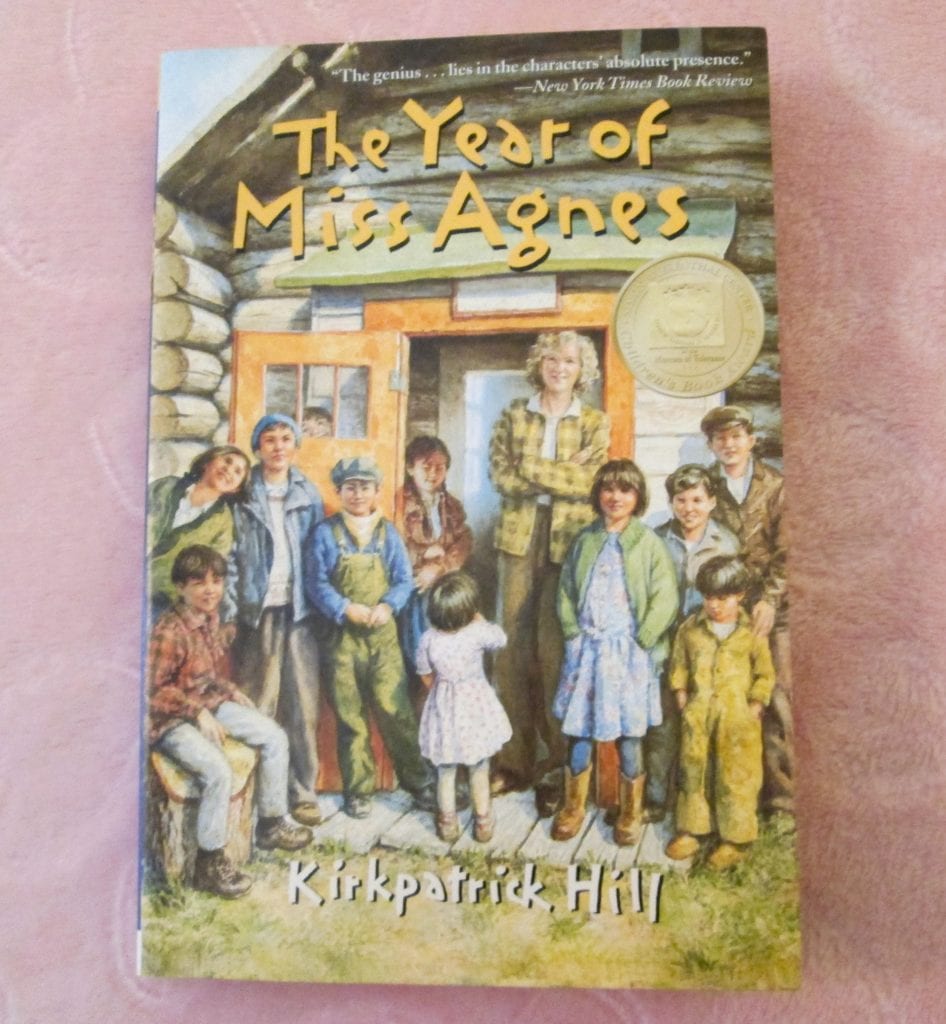
There is nothing better for children or adults to read than a chapter book that teaches history, life lessons, interacting with others that are different from you, how to enjoy the small things in life, and stimulates the brain to want to know more. That is what you will find in this sweet little book, The Year of Miss Agnes, by Kirkpatrick Hill. I have to give a big thank you to my daughter, Allison Martin, for sharing this book with me.
The setting of this book is the Alaskan “bush” and the year is 1948. The story is about a young girl, Frederika, age ten, who lives with her single mom (her dad died of Tuberculosis) and twelve-year-old deaf sister. The small community has had numerous teachers in the past that never stay because the fishing trade of the families cause the children to reek of fish smells and there seems to be problems with disciplining the older boys. Then Miss Agnes arrives.
The story is told in first person narrative style from the main character Frederika, known to the village as Fred. I loved the creativity of the author as she developed pictures for the reader by letting the story unfold as seen through the eyes of a ten-year-old. For younger readers, it makes the book very relatable. For adults, you read between the lines and get a whole different picture.
Miss Agnes is the first teacher to stay for the entire school year. She is an older, seasoned teacher and has developed a different style of teaching that captures the hearts of her learners. She meets them at their levels and areas of interests. When Miss Agnes finds out Fred’s sister, Bokko, is deaf, she gets books to help the whole school learn sign language and invites her in for the first time of schooling.
The girl’s mother sees no reason for the education of her daughters and has become somewhat embittered by life circumstances. Although she puts up a fuss, she doesn’t stop the girls from going to school.
Miss Agnes opens a world of learning to her students with maps, teaching them to read, teaching them to add and subtract, and sharing stories they have never heard before. She uses books like Robin Hood, The Adventures of Sherlock Holmes, Kidnapped, a book about King Arthur, and fairy tales to draw the children into adventures. She uses art and music to open up a world of beauty. And, Miss Agnes staples paper together and writes books about each student. By her descriptions, they are able to see good things about themselves through the eyes of another person, and it makes their desire to read even stronger, as we all like to read about ourselves.
For Christmas, the children perform a play based on Charles Dickens’, A Christmas Carol, which pulls all the adults from the village into the learning process. When teaching the children sign language for Bokko’s sake, the children pick it up faster than Miss Agnes and after awhile she asks the children for the signs she can’t recall, as she says, “I have an old brain,….It’s not good. A young brain is good.” (p.102) The whole town gets involved in the process of learning sign language as the children teach the adults.
The book progresses through the school year with all the children developing a hunger for learning. Miss Agnes has only agreed to one year of teaching as her heart yearns to go back to England, where she is from originally. Fred and her family leave for the summer to go to a camp where they catch and preserve salmon as part of their living.
The book closes with the family coming back from camp, unsure as to whether they will even have a teacher for the new year. I encourage you to find a copy of this book to find out the sweet ending. This is a great book for children reading chapter books. It is a great book for parents if you are looking for ways to get at the heart of teaching your child in a way that produces a lifetime of learning.
I will close with some quotes from the book that share the wisdom of Miss Agnes and what her style of teaching accomplished. I found her represented thought processes especially endearing and insightful.
“Miss Agnes didn’t think school was just for kids. ‘You have to keep learning all your life,’ she said.” (p.64)
“And then she’d make us write stories, because she said that writing was just reading backwards, and you learned to read by writing just as well as reading. Reading backwards. We thought that was very funny.” (pp.92-93)
Fred and Bokko’s Mamma, had a change of heart by the end of the book. In Fred’s voice we hear, “We could tell she (their mother) didn’t think school was a waste of time anymore. It seemed like everything reminded me and Bokko of Miss Agnes. Everything had something to do with what we learned from her, as if we just woke up to see the world around us, and way beyond us.” (p.111)
And that is what learning is all about. Life learning. Waking up and seeing the world around us through God’s provision. Finding joy in learning. If you are able to pass that on to your children, learn to do that for yourself, and never stop no matter your age, you will live a very fruit-filled life.

I absolutely loved this book! I think every teacher and homeschool parent should read it.
Absolutely!:)